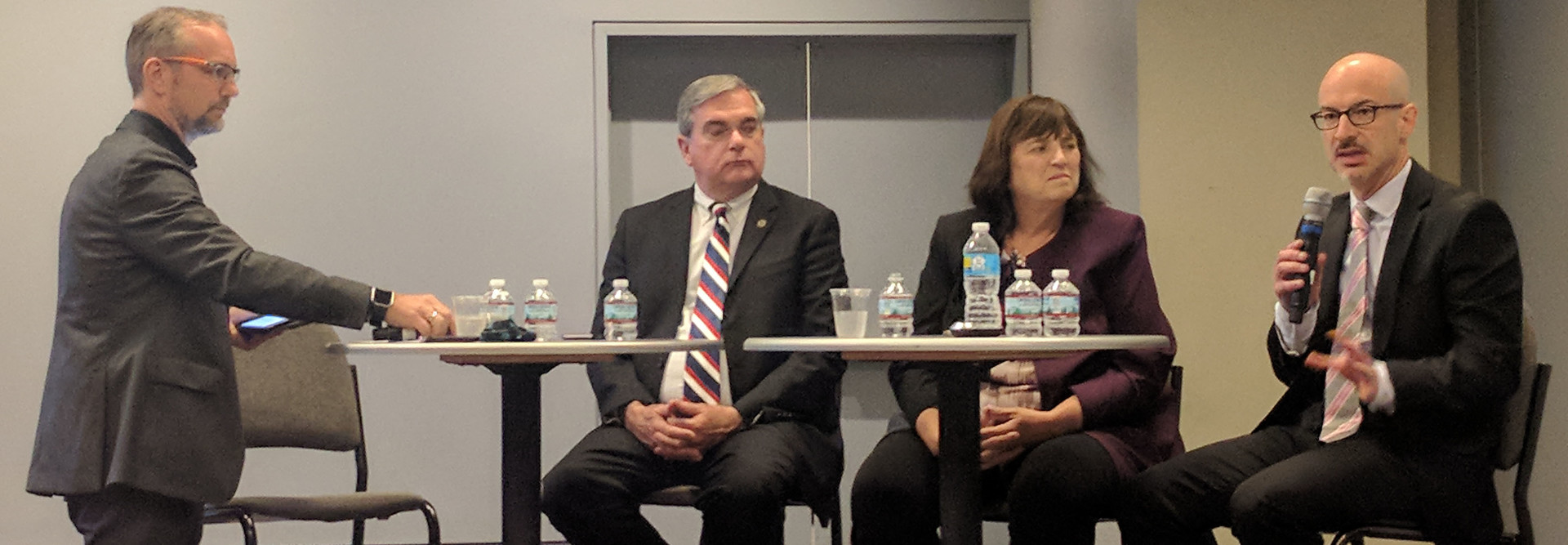Smart Cities Week 2017: How to Bridge the Digital Divide Amid a Smart City Revolution
Think about where the Wi-Fi hotspots are in your town: the public library, the school, coffee shops downtown. But as connectivity becomes faster, smarter and more attainable in many areas, in other, less affluent parts of the city and country, it’s still out of reach in many ways.
“Digitization is also producing digital divides,” said Bas Boorsma, digitization lead for North Europe at Cisco and author of the book A New Digital Deal, speaking at the “Bridging the Digital Divide: Best Practices in Broadband, Public WiFi and Digital Literacy” panel at the Smart Cities Week conference in Washington, D.C.
Boorsma noted that the digital divides that exist today are not the same as those we experienced 20 years ago, which he described as “young versus old,” when younger generations were online while older generations remained offline.
“We’re now looking at many shades of gray when it comes to digitization,” said Boorsma, the panel moderator.
As smart city projects grow and connectivity becomes a critical aspect of economic opportunity, governments will need to step in, in order to stem the growth of the digital divide and bring equitable digitization to all communities.
More than that, however, cities can also use connectivity and advanced communications networks to facilitate economic growth, citizen engagement, access to healthcare, education and more.
“Many people are somewhat online but they fail to leverage the full potential to integrate it into entrepreneurial opportunities — building businesses and releveraging the digital tools that could support their businesses, bringing digitization to schools to improve education,” said Boorsma. “There are so many levels of digital literacy that need to be addressed.”
So how can governments go about ensuring that connectivity is leveraged appropriately beyond the more affluent areas of their cities?
Apply Lessons Learned from Previous Wi-Fi Projects
To begin, cities can plan and launch an all-encompassing Wi-Fi initiative that seeks to foster citywide connectivity. This is the goal of Philadelphia leadership, which is currently using broadband to advance digital literacy and inclusion across its community through its Broadband Technology Opportunities Program, launched in 2009.
While Philadelphia is now working to build out a smart city network and accompanying digital literacy programs, its initial pass at a municipal Wi-Fi network, Wireless Philadelphia, was less than successful. Launched in 2004, the project failed in 2009. Though it certainly had its flaws, Andrew Buss, the deputy CIO for innovation management within Philadelphia’s Office of Innovation and Technology, said that it helped to lay the groundwork for future Wi-Fi deployments both in government and the community.
“It’s a failed initiative by any standard, but some things came out of it that are pretty interesting,” he said. “Because everyone was so in to Wireless Philadelphia for that period of time, what ends up happening is we created all these really active communities around the topic of broadband — very committed people, community organizations, individuals, people who are excited about the issue.”
Moreover, it created a physical infrastructure, a citywide network of wireless technologies that the city could leverage in its next project.
But Buss said he also learned a valuable lesson about rushing to be a technology first adopter.
“Wireless Philadelphia, in a way, was ahead of its time. The technology issues were not worked out,” he said. “The technology changed faster than the city could implement the program, frankly, and that was a big challenge.”
Train Citizens How to Leverage Connectivity to the Fullest
Ensuring that smart city projects benefit everyone requires more than just providing people with access. Many people need help to fully understand the digital realm and how to leverage opportunities from it.
“It’s not just if you have it, it’s: Do you have the skills to use it and can you use those skills to benefit the community?” said Jean Rice, a senior broadband program specialist for the National Telecommunications and Information Administration’s BroadbandUSA program.
Many of the programs that aim to improve digital literacy go beyond a single citizen level. They look to educate businesses on how to better use technology or to schools to ensure the workforce is there for those companies that aim to build on tech know-how.
“It is an ecosystem of work that is both access and inclusion training,” Rice said.
So where can a community start to build out this ecosystem? Established community organizations can provide the necessary base.
“Whatever the community you’re working with, you want to work with a trusted organization; so whether that’s a nonprofit, a library or a school, whatever, that’s an important place to start to set up some new digital inclusion sections,” said Rice.
Read more from StateTech’s coverage of Smart Cities Week 2017 here.









